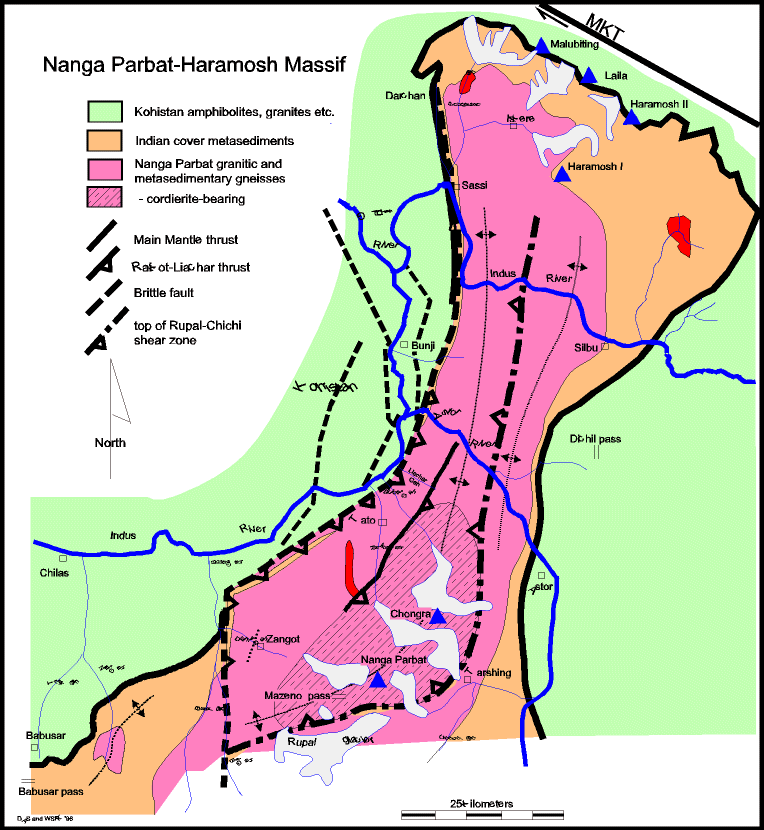Outline geological map of the Nanga Parbat-Haramosh Massif
 Granitoid
and metasedimentary gneisses of the Indian continental basement form the
core of the NPHM. They are mantled by metasedimentary rocks derived from
the pre-collisional passive margin cover of India. Along the eastern, northern
and southwestern portions of the margin, rocks of the Kohistan-Ladakh island
arc suite contact these across the mylonites of the Main Mantle Thrust
[MMT], which has been distorted by the rise of the NPHM into a large crustal-scale
antiformal fold. This antiformal structure has been modified by overthrusting
to the NW along the central part of the western margin [Raikot-Liachar
Thrust]. The regional antiform is more complex in detail, with two recognisable
antiforms separated by a zone of mylonites, including pelitic schist and
amphibolite. In the Astor River section, the mylonites form a “pinched”
syncline, characteristic of basement-cover contacts. We interpret this
newly recognised zone to connect with the Rupal-Chhichi Shear Zone south
east of Nanga Parbat peak. This zone of east/southeast-directed thrusting
combines with the Raikot-Liachar Thrust on the western margin of the NPHM
to produce a large-scale “pop-up” structure for the core of the NPHM.
Granitoid
and metasedimentary gneisses of the Indian continental basement form the
core of the NPHM. They are mantled by metasedimentary rocks derived from
the pre-collisional passive margin cover of India. Along the eastern, northern
and southwestern portions of the margin, rocks of the Kohistan-Ladakh island
arc suite contact these across the mylonites of the Main Mantle Thrust
[MMT], which has been distorted by the rise of the NPHM into a large crustal-scale
antiformal fold. This antiformal structure has been modified by overthrusting
to the NW along the central part of the western margin [Raikot-Liachar
Thrust]. The regional antiform is more complex in detail, with two recognisable
antiforms separated by a zone of mylonites, including pelitic schist and
amphibolite. In the Astor River section, the mylonites form a “pinched”
syncline, characteristic of basement-cover contacts. We interpret this
newly recognised zone to connect with the Rupal-Chhichi Shear Zone south
east of Nanga Parbat peak. This zone of east/southeast-directed thrusting
combines with the Raikot-Liachar Thrust on the western margin of the NPHM
to produce a large-scale “pop-up” structure for the core of the NPHM.
Return to Abstract/Index
 Granitoid
and metasedimentary gneisses of the Indian continental basement form the
core of the NPHM. They are mantled by metasedimentary rocks derived from
the pre-collisional passive margin cover of India. Along the eastern, northern
and southwestern portions of the margin, rocks of the Kohistan-Ladakh island
arc suite contact these across the mylonites of the Main Mantle Thrust
[MMT], which has been distorted by the rise of the NPHM into a large crustal-scale
antiformal fold. This antiformal structure has been modified by overthrusting
to the NW along the central part of the western margin [Raikot-Liachar
Thrust]. The regional antiform is more complex in detail, with two recognisable
antiforms separated by a zone of mylonites, including pelitic schist and
amphibolite. In the Astor River section, the mylonites form a “pinched”
syncline, characteristic of basement-cover contacts. We interpret this
newly recognised zone to connect with the Rupal-Chhichi Shear Zone south
east of Nanga Parbat peak. This zone of east/southeast-directed thrusting
combines with the Raikot-Liachar Thrust on the western margin of the NPHM
to produce a large-scale “pop-up” structure for the core of the NPHM.
Granitoid
and metasedimentary gneisses of the Indian continental basement form the
core of the NPHM. They are mantled by metasedimentary rocks derived from
the pre-collisional passive margin cover of India. Along the eastern, northern
and southwestern portions of the margin, rocks of the Kohistan-Ladakh island
arc suite contact these across the mylonites of the Main Mantle Thrust
[MMT], which has been distorted by the rise of the NPHM into a large crustal-scale
antiformal fold. This antiformal structure has been modified by overthrusting
to the NW along the central part of the western margin [Raikot-Liachar
Thrust]. The regional antiform is more complex in detail, with two recognisable
antiforms separated by a zone of mylonites, including pelitic schist and
amphibolite. In the Astor River section, the mylonites form a “pinched”
syncline, characteristic of basement-cover contacts. We interpret this
newly recognised zone to connect with the Rupal-Chhichi Shear Zone south
east of Nanga Parbat peak. This zone of east/southeast-directed thrusting
combines with the Raikot-Liachar Thrust on the western margin of the NPHM
to produce a large-scale “pop-up” structure for the core of the NPHM.